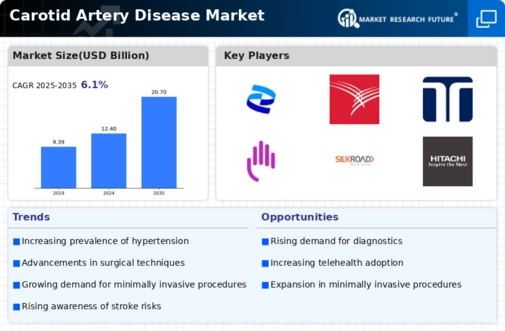Market Share
Carotid Artery Disease Market Share Analysis
In the realm of Carotid Artery Disease Treatment, companies deploy various strategies to carve out their place and capture market share. One of the primary strategies is centered around innovation and technological advancement. Companies invest heavily in research and development to devise novel treatments and procedures for managing carotid artery disease. These innovations may include minimally invasive surgical techniques, advanced stenting procedures, or cutting-edge medications aimed at preventing plaque buildup or reducing the risk of stroke. By offering innovative solutions that promise improved patient outcomes and fewer complications, companies can distinguish themselves in the market and attract healthcare providers and patients seeking the most effective treatments.
Pricing strategy is another crucial factor in market share positioning within the Carotid Artery Disease Treatment market. Some companies opt for competitive pricing strategies, aiming to gain market share by offering their treatments at lower costs compared to competitors. This approach is particularly effective in regions where healthcare costs are a significant concern for patients and healthcare providers. Conversely, other companies may adopt premium pricing strategies, positioning their treatments as high-quality options that offer superior efficacy and safety. This allows them to target customers who prioritize quality and are willing to pay a premium for the best available treatments.
Distribution channels also play a vital role in market share positioning. Companies may focus on expanding their distribution networks to ensure that their treatments are readily accessible to healthcare providers and patients. This might involve partnering with medical device distributors, pharmaceutical companies, or healthcare facilities to reach a broader audience. Additionally, companies may invest in digital distribution channels, such as telemedicine platforms or online pharmacies, to enhance accessibility and convenience for patients seeking treatment for carotid artery disease.
Marketing and branding strategies are essential for establishing a strong market presence and gaining market share in the Carotid Artery Disease Treatment market. Companies often invest in building reputable brands that are associated with excellence in patient care and clinical outcomes. This could involve developing targeted marketing campaigns, sponsoring medical conferences and events, or collaborating with key opinion leaders in the field. By positioning themselves as leaders in carotid artery disease treatment and emphasizing the benefits of their treatments, companies can attract the attention of healthcare providers and patients and differentiate themselves from competitors.
Strategic partnerships and collaborations are instrumental in expanding market share within the Carotid Artery Disease Treatment market. Companies may form alliances with hospitals, research institutions, or other healthcare organizations to leverage complementary expertise and resources. These partnerships can facilitate collaborative research projects, joint clinical trials, or co-marketing efforts to raise awareness about available treatments. By working together with strategic partners, companies can strengthen their position in the market and gain a competitive edge.
Furthermore, customer-centric strategies are increasingly important in market share positioning within the Carotid Artery Disease Treatment market. Companies must understand the needs and preferences of both healthcare providers and patients and tailor their treatments and services accordingly. This could involve offering personalized treatment plans, providing comprehensive patient education and support programs, or implementing user-friendly medical devices and technologies. By focusing on delivering value and improving patient outcomes, companies can build trust and loyalty among healthcare providers and patients, ultimately driving market share growth.
Lastly, regulatory compliance and quality assurance are paramount in the Carotid Artery Disease Treatment market. Companies must ensure that their treatments meet stringent regulatory standards and undergo rigorous testing to ensure safety and efficacy. By adhering to regulatory requirements and maintaining high-quality standards, companies can build trust and confidence among customers and stakeholders, which is essential for gaining market share and sustaining long-term success in the Carotid Artery Disease Treatment market.









Leave a Comment